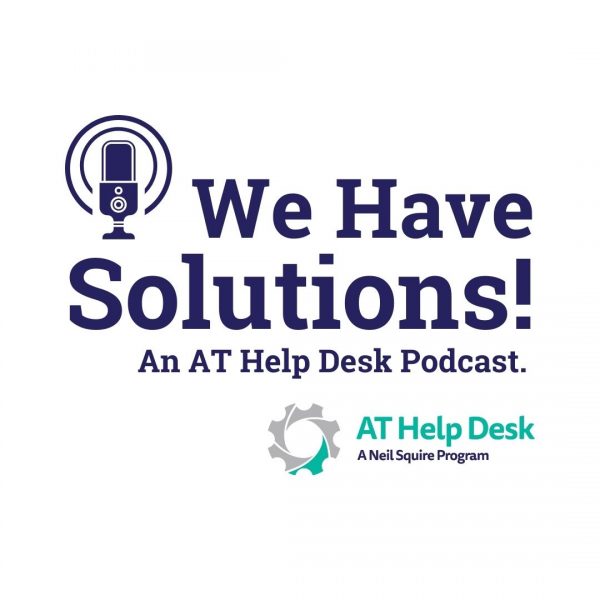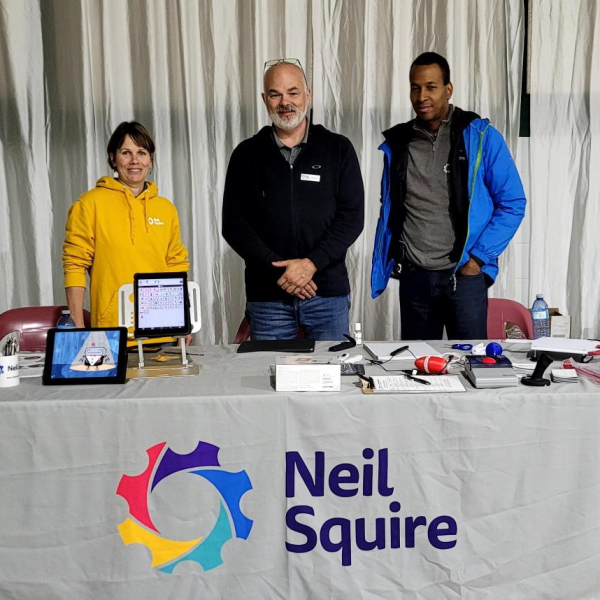We Have Solutions! – Episode 25: Rabbit R-1, AT News, and Ten Tips for Adopting AT

On the latest episode, Nakia and Seaver will be looking at the new AI-powered pocket companion called the Rabbit R1. Then we talk a bit about what’s new in the world of AT, and finally, we list our top ten tips for adopting AT.
Ten Tips for Adopting Assistive Technology

To celebrate the AT Help Desk’s 10th anniversary, we’ve compiled a list of our top ten tips for adopting assistive technology. If you’re someone who has recently been recommended assistive technology, or if you’ve been using AT for years but you’re wondering how to use it as effectively as possible, then this list is for you!
Ten Years of AT Help Desk by the Numbers
This year, our AT Help Desk program celebrates 10 years of service in New Brunswick. Here’s a breakdown of the impact:
AT Help Desk Celebrates Ten Years of Answering Your Questions About Assistive Technology

Imagine that you have a technical problem or a computer question at work, you might call your company’s IT help desk. But what if you have a disability and you have a question about assistive technology? Maybe you need to find a device that will help you with your needs, or maybe your assistive technology isn’t working right and you need help. That’s where Neil Squire’s AT Help Desk comes in.
In 2024, the AT Help Desk celebrates 10 years of serving New Brunswickers with disabilities. Whether you’re working, studying, simply need an assistive technology that makes your life a little easier, or are calling on behalf of a client, student, or family member, anyone can reach out. And all services are available in English and French.
Brilliant App: Advanced Math and Science Courses

For persons with disabilities, learning apps are a great way to approach new concepts for a couple reasons. First, they allow you to learn at a pace that is more suited to your specific learning style. Secondly, these apps are not only able to take advantage of your devices built in accessibility features, but they also often offer their own suite of accessibility options.
We’ve covered a few different math courses in the past, but most of those apps were focused on students from K-12. Today, we are going to look at a Math and Science learning app that was specifically designed for post-secondary students and professionals.
We Have Solutions! – Episode 24: NFC-Based Automation, Reading Tools for Teams, and Our New Favourite AI

On this episode, our AT Help Desk team talks about NFC-based automation for persons with disabilities, the Reading Progress and Reaching Coach tools that are now available for Teams, and finally we look at another AI chatbot that just might be our new favorite.
Reading Coach: A Teams-Based Learning Tool

By now most of us are aware of and have likely used Microsoft Teams. For those who aren’t familiar, Teams is a widely used communication platform that integrates all things Microsoft into a centralized space. Teams is also an incredible tool for teachers with a wide range of educational tools. But with the plethora of supporting apps that integrate into Teams, there’s going to be apps and add-ons that fly under the radar. Today we are going to talk about one of Teams’ supporting apps that you should definitely be aware of!
Top Three AI Chatbots and How to Use Them

In a previous e-bulletin we started to explore the concept of using AI as AT. We learned that there are many ways in which this new technology can be helpful to students, professionals, persons with disabilities, and beyond. We discovered that AI chatbots were even better at finding and synthesizing information than a traditional browser, and that the flexible, conversational nature of this technology is ideal for diving into a variety of complicated subjects. With that in mind, we are going to dive even deeper into what these chatbots are capable of as well as identifying and comparing the top three chatbots on the market right now.
Resource Spotlight: PRC-Saltillo

Today we are going to do a quick spotlight on a great assistive technology resource that we have recently discovered. This resource deals with Augmentative and Alternative Communication (AAC) technology, so before we go any further, we want to mention that the New Brunswick Association of Speech-Language Pathologists and Audiologists is the province’s main resource for everything related to speech and audio challenges. Click here to check out their website.
There’s not always a ton of resources and knowledge available when it comes to AAC. This probably has a lot to do with the specialized nature of AAC technology. This tech is often expensive, and it usually requires a bit of training to use properly.
Udemy

Adult learning can be an incredibly expensive and time-consuming process, but it doesn’t have to be! With the advent of online learning there are more choices than ever in how we can approach post-secondary education. There’s a lot of options out there, and we have covered some of them in past e-bulletins, so if you’re interested in even more online learning options, please click here. However, the app that we are looking at today certainly deserves its time in the spotlight, especially because of the strides they’ve recently been making to deliver an accessible and universally designed product.
Udemy is an online learning system that is available on iOS, Android, PC, and Mac. The courses are adult-centered and deal with a wide variety of practical skills. There are courses on software development, business, photography, editing, teaching and academics, IT, music, and much more.



